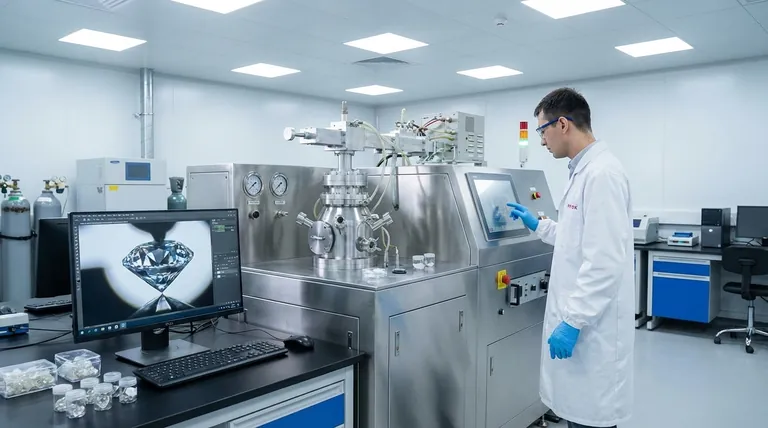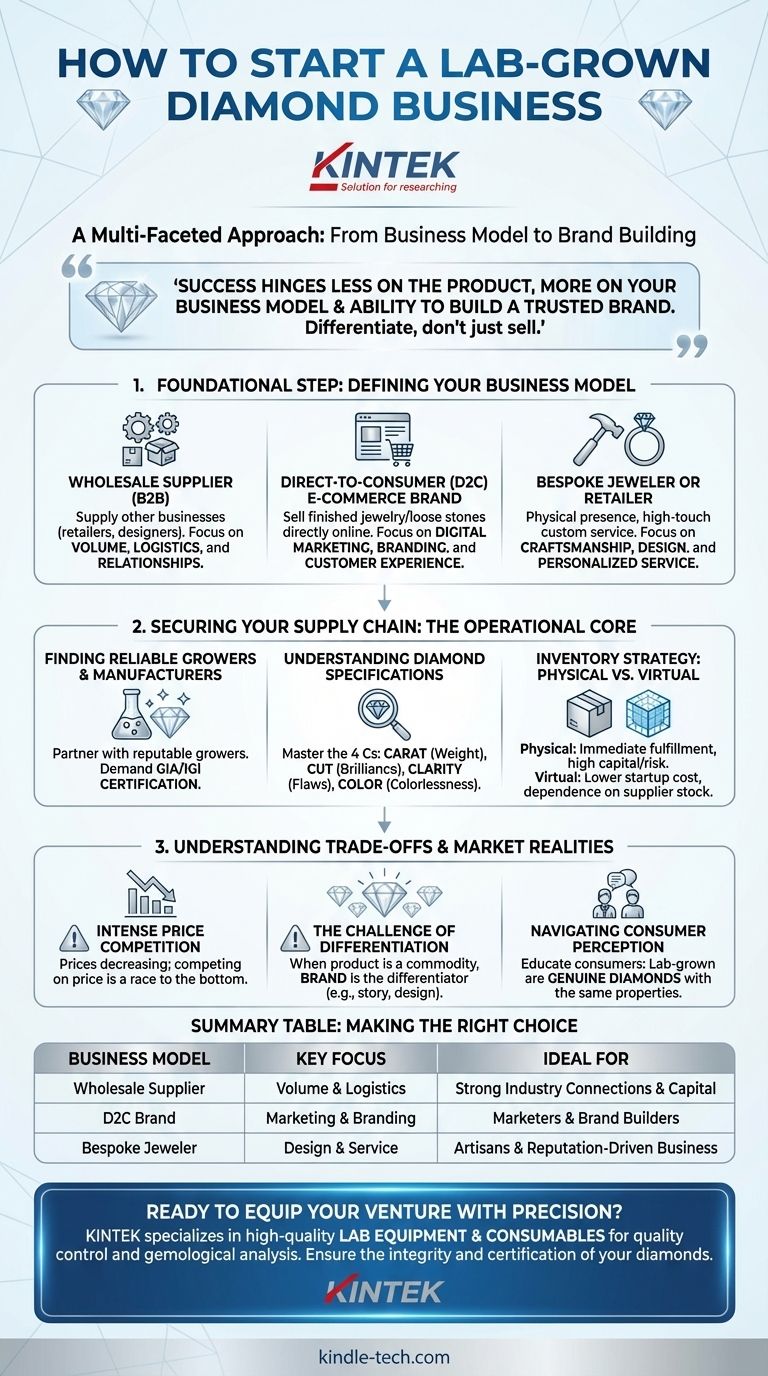Starting a lab-grown diamond business requires a multi-faceted approach that goes beyond simply acquiring and selling stones. The process involves defining a clear business model, establishing a reliable and high-quality supply chain, building a trusted brand, and creating effective sales and marketing channels to reach your target audience.
Your success in the lab-grown diamond market will hinge less on the product itself and more on your chosen business model and ability to build a trusted brand. The core strategic decision is not if you should sell lab diamonds, but how you will differentiate your business in an increasingly competitive field.

Foundational Step: Defining Your Business Model
Before sourcing a single diamond, you must decide what kind of company you will be. This choice dictates every subsequent step, from your supply chain to your marketing budget.
The Wholesale Supplier (B2B)
This model focuses on supplying lab-grown diamonds to other businesses, such as jewelry retailers, designers, and manufacturers.
Success here depends on volume, logistics, and relationships. Your value is in providing a consistent, well-priced, and reliable supply of stones to your business clients.
The Direct-to-Consumer (D2C) E-commerce Brand
This is the most common model for new entrants. You build a brand and sell finished jewelry (like engagement rings) or loose stones directly to the public through your own website.
This path requires significant investment in digital marketing, branding, and customer experience. You are not just selling a diamond; you are selling a story and a promise.
The Bespoke Jeweler or Retailer
This model involves a physical presence or a high-touch, service-oriented online process. You work directly with clients to create custom pieces.
Your competitive advantage lies in craftsmanship, design, and personalized service. This is often a lower-volume, higher-margin business built on reputation and artistry.
Securing Your Supply Chain: The Operational Core
Your product is your promise. A flawed or inconsistent supply chain will undermine your brand and profitability, regardless of your business model.
Finding Reliable Growers and Manufacturers
You must partner with reputable lab-diamond growers who can provide consistent quality and quantity. As the reference material implies, staying updated with innovations and manufacturing techniques is key.
Demand formal certification for your stones from respected gemological labs like the GIA (Gemological Institute of America) or IGI (International Gemological Institute). This is non-negotiable for building customer trust.
Understanding Diamond Specifications
You must be an expert in the "4 Cs":
- Carat: The weight of the diamond.
- Cut: The quality of the diamond's angles and facets, which determines its brilliance.
- Clarity: The absence of internal or external flaws.
- Color: The degree of colorlessness.
This knowledge is critical for sourcing inventory and educating your customers.
Inventory Strategy: Physical vs. Virtual
Holding a physical inventory of diamonds provides immediate fulfillment but requires immense capital and risk.
A virtual inventory model, where you access a supplier's inventory via an API for your website, dramatically lowers startup costs. However, it can create logistical challenges and makes you dependent on your supplier's stock.
Understanding the Trade-offs and Market Realities
The lab-grown diamond market is not a guaranteed path to success. You must be aware of the significant challenges.
Intense Price Competition
As technology improves and more producers enter the market, the price of lab-grown diamonds has been steadily decreasing. Competing solely on price is a race to the bottom.
The Challenge of Differentiation
When the product itself becomes a commodity, your brand becomes your primary differentiator. Why should a customer buy the exact same IGI-certified stone from you instead of a competitor? Your answer could be a better customer experience, a more compelling brand story (e.g., sustainability), or unique designs.
Navigating Consumer Perception
While acceptance is growing, some consumers still have questions about the value and authenticity of lab-grown diamonds. Your role is to be an educator, clearly communicating that they are genuine diamonds with the same physical, chemical, and optical properties as mined diamonds.
Making the Right Choice for Your Venture
Your path forward depends on your capital, expertise, and long-term goals.
- If your primary focus is scale and B2B sales: Concentrate on building exclusive relationships with top-tier growers and optimizing your logistics for efficiency.
- If your primary focus is building a D2C brand: Invest heavily in creating a unique brand identity, a beautiful e-commerce experience, and a robust digital marketing engine.
- If your primary focus is craftsmanship and service: Prioritize developing your design skills or partnerships and building a business based on exceptional, high-touch customer relationships.
Ultimately, your success will be defined not by the diamonds you sell, but by the trust and value you build around them.
Summary Table:
| Key Decision | Description | Ideal For |
|---|---|---|
| Wholesale Supplier (B2B) | Supply diamonds to retailers and jewelers. Focus on volume and logistics. | Entrepreneurs with strong industry connections and capital for bulk inventory. |
| Direct-to-Consumer (D2C) Brand | Sell finished jewelry or loose stones online. Focus on digital marketing and branding. | Marketers and brand builders who can create a compelling customer experience. |
| Bespoke Jeweler/Retailer | Offer custom, high-touch service and craftsmanship. Focus on design and personalization. | Artisans and designers seeking a high-margin, reputation-driven business. |
Ready to equip your lab-grown diamond venture with precision and reliability? At KINTEK, we specialize in providing high-quality lab equipment and consumables essential for quality control and gemological analysis. Whether you're a startup jeweler or an established retailer, our tools help ensure the integrity and certification of your diamonds. Contact our experts today to discuss how KINTEK can support your business's success.
Visual Guide

Related Products
- Cylindrical Resonator MPCVD Machine System Reactor for Microwave Plasma Chemical Vapor Deposition and Lab Diamond Growth
- 915MHz MPCVD Diamond Machine Microwave Plasma Chemical Vapor Deposition System Reactor
- Microwave Plasma Chemical Vapor Deposition MPCVD Machine System Reactor for Lab and Diamond Growth
- Customer Made Versatile CVD Tube Furnace Chemical Vapor Deposition Chamber System Equipment
- Multi Heating Zones CVD Tube Furnace Machine Chemical Vapor Deposition Chamber System Equipment
People Also Ask
- What machine is used to make lab-grown diamonds? Discover the HPHT & CVD Technologies
- What is the difference between MPCVD and HFCVD? Choose the Right CVD Method for Your Application
- What is a microwave plasma reactor? Unlock Precision Synthesis of High-Performance Materials
- What are the limitations of diamonds? Beyond the Myth of Perfection
- How do lab-grown diamonds compare to natural diamonds? Uncover the Truth About Origin, Price, and Value



















